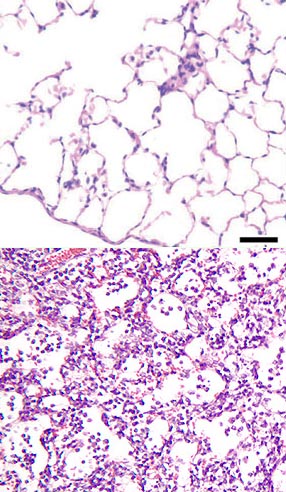Pneumonia pathophysiology
|
Pneumonia Microchapters |
|
Diagnosis |
|---|
|
Treatment |
|
Case Studies |
|
Pneumonia pathophysiology On the Web |
|
American Roentgen Ray Society Images of Pneumonia pathophysiology |
|
Risk calculators and risk factors for Pneumonia pathophysiology |
Editor(s)-in-Chief: C. Michael Gibson, M.S., M.D. [1]; Associate Editor(s)-In-Chief: Priyamvada Singh, M.D. [2]
Overview
Bacteria and fungi typically enter the lung with inhalation. Once inside the alveoli, these microbes travel into the spaces between the cells and also between adjacent alveoli through connecting pores. This invasion triggers the immune system response by sending white blood cells responsible for attacking microorganisms (neutrophils) to the lungs resulting in manifestations of pneumonia.
Pathophysiology
- Main article:Eosinophilic pneumonia pathophysiology
- Main article:Hospital-acquired pneumonia pathophysiology
- Main article:Pneumocystis jirovecii pneumonia pathophysiology
- Main article:Mycoplasma pneumonia pathophysiology
Aspiration Pneumonia Pathophysiology
The location is often gravity dependent, and depends on the patient position. Generally the right middle and lower lung lobes are the most common sites of infiltrate formation due to the larger caliber and more vertical orientation of the right mainstem bronchus.
Patients who aspirate while standing can have bilateral lower lung lobe infiltrates. The right upper lobe is a common area of consolidation in alcoholics who aspirate in the prone position. Depending on the acidity of the aspirate, a chemical pneumonitis can develop, and bacterial pathogens (particularly anaerobic bacteria) may add to the inflammation.
Microscopic Pathology

Major Points for Pathogenesis of Adults with Hospital-acquired, Ventilator-associated, and Healthcare-associated Pneumonia (DONOT EDIT) [1]
| “ |
Major Points for Pathogenesis1 Sources of pathogens for HAP include healthcare devices, the environment (air, water, equipment, and fomites), and commonly the transfer of microorganisms between the patient and staff or other patients (Level II) . 2 A number of host- and treatment-related colonization factors, such as the severity of the patient's underlying disease, prior surgery, exposure to antibiotics, other medications, and exposure to invasive respiratory devices and equipment, are important in the pathogenesis of HAP and VAP (Level II). 3 Aspiration of oropharyngeal pathogens, or leakage of secretions containing bacteria around the endotracheal tube cuff, are the primary routes of bacterial entry into the lower respiratory tract (Level II). 4 Inhalation or direct inoculation of pathogens into the lower airway, hematogenous spread from infected intravenous catheters, and bacterial translocation from the gastrointestinal tract lumen are uncommon pathogenic mechanisms (Level II). 5 Infected biofilm in the endotracheal tube, with subsequent embolization to distal airways, may be important in the pathogenesis of VAP (Level III) 6 The stomach and sinuses may be potential reservoirs of nosocomial pathogens that contribute to bacterial colonization of the oropharynx, but their contribution is controversial, may vary by the population at risk, and may be decreasing with the changing natural history and management of HAP (Level II) |
” |
For Level of evidence and classes click here.
Videos
{{#ev:youtube|bTqgAfQv0p4}}
Lobar Pneumonia
{{#ev:youtube|dxXrxYIXbL8}}
Pneumocystis Pneumonia
{{#ev:youtube|KfF_pPUjR8o}}
{{#ev:youtube|zSdK_yWe_S4}}
Aspiration Pneumonia
{{#ev:youtube|bTqgAfQv0p4}}
Aspiration Pneumonia, Infant
{{#ev:youtube|RXnnEuEZ0BY}}
Desquamative Interstitial Pneumonia
{{#ev:youtube|G0TFmAAYjWU}}
Legionella Pneumonia
{{#ev:youtube|BDWEnPilfIQ}}
Measles Pneumonia
{{#ev:youtube|v80kA_dt6EE}}
Abscess, Bronchopneumonia
{{#ev:youtube|wO2x7O2KEZY}}
References
- ↑ "Guidelines for the management of adults with hospital-acquired, ventilator-associated, and healthcare-associated pneumonia". American Journal of Respiratory and Critical Care Medicine. 171 (4): 388–416. 2005. doi:10.1164/rccm.200405-644ST. PMID 15699079. Retrieved 2012-09-13. Unknown parameter
|month=ignored (help)